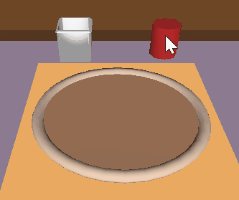
Working in my passion project temporarily named VCG I had to implement painting and it was surprisingly hard to figure out how to get working because most information out there is for Godot 3 and some functions and variables related to this have changed so all that information is deprecated now. Anyway, finally got it working after banging my head on it for a few days, here you have it.
To do this we need to get the UV position that matches the 3D world position we’re clicking, blend the brush texture onto the mesh’s material texture, and then update the texture and material.
Starting with getting these coordinates I used Alfred Baudisch’s example, which helped a lot! Had to update a few lines from the changes that happened between Godot 3 and 4, so the updated version of his script would be: pastebin.
Now that we can get the coordinates using get_uv_coords(point, normal, transform = true) we can paint with our brush using blend_rect().
extends Node
var img : Image
var tex : ImageTexture
var mesh : GeometryInstance3D = null
var rect : Rect2i
var brush : Image = Image.new()
var brushSize
var pixels = 256
func _create_image():
# your image and your brush need to have the same format, in my case it's RGBA8
img = Image.create(pixels, pixels, false, Image.FORMAT_RGBA8)
img.fill(Color(0.82, 0.6, 0.451)) # this is the color I want my background to be
brushSize = brush.get_height() / 2
rect = Rect2i(Vector2i(brushSize,brushSize), Vector2i(brushSize,brushSize))
tex = ImageTexture.create_from_image(img)
mesh.material_override.set("shader_parameter/Mask_texture", tex)
func _get_mesh():
for child in get_children():
if child is GeometryInstance3D:
mesh = child
func _ready():
brush = brush.load("res://Art/Textures/T_TomatoSauce_brushes.png")
_get_mesh()
_create_image()
func random_brush_splat(): # choose a random sprite from my 2x2 atlas texture
var index : Vector2i = Vector2i(0,0)
if randi() % 2:
index = Vector2i(brushSize, 0)
if randi() % 2:
index = Vector2i(index.x, brushSize)
rect = Rect2i(Vector2i(index.x, index.y), Vector2i(brushSize,brushSize))
func draw_on_sprite(coords):
coords = (coords * pixels) - Vector2(brushSize, brushSize)/2
random_brush_splat()
img.blend_rect (brush, rect, Vector2i(coords.x,coords.y))
tex.update(img)
mesh.material_override.set("shader_parameter/Mask_texture", tex)
For some reason you have to set the material texture every time you update it, both the texture file and the material itself. This was driving me insane because I knew the texture was updating if I checked the pixel but it wasn’t changing at all in my viewport.
And in this case I’ll do you one better: flipbook brush using the function random_brush_splat(). So there’s variation on the texture and it doesn’t look like you’re dragging your Windows 98 error window.
So now we call that draw_on_sprite(coords) function from my mouse event function that comes from an Area3D node that I have on my mesh I want to paint.
func _on_area_3d_input_event(camera, event, position, normal, _shape_idx):
if TouchInput.checkClick(event).y and coords != position: # dragging
# drawing tomato sauce
if coords.distance_squared_to(position) > 0.04: # give some space between splats
coords = position
if (PlayerVariables.ingredientHeld != null):
if PlayerVariables.ingredientHeld is Tomato:
$pizza_dough_flat/Area3D.set_mesh ($pizza_dough_flat/Pizza_dough)
var uv_coords = $pizza_dough_flat/Area3D.get_uv_coords(position, normal)
if (uv_coords != null):
$pizza_dough_flat.draw_on_sprite(uv_coords )For those curious, this is my TouchInput.checkClick(event) function:
class_name Touch_input extends Node
var is_dragging : bool = false
var is_click : bool = false
func checkClick(event):
is_click = false
is_dragging = false
if (InputEventScreenTouch and !event.is_pressed()) and (Input.is_action_pressed("click")): # dragging
is_dragging = true
elif (event is InputEventMouseButton): # tap - avoids auto double-tap
is_click = true
return Vector2(is_click, is_dragging)It’s in an autoloaded script, they work in a similar way that static classes do in Unity.
And there you have it folks.
Banner illustration by André Marí Coppola (x)

Hi Erika!
Thank you so much for this great content! Do you happen to have the project/ code for Godot 3 or tips on how painting there is realized differently than in this example?
Kind regards,
seyn
Hi! Sorry I do not really have experience with Godot 3 so I wouldn’t be able to tell you.
I do share the original project I learned from which is made in Godot 3 though, from Alfred Baudisch: https://github.com/alfredbaudisch/GodotRuntimeTextureSplatMapPainting/blob/master/Scripts/VertexPositionMapper.gd
Thank you so much
It will be better if you post a project with the implementation of this code. Because it’s difficult to recreate the scene.
Sorry I won’t be uploading a project as I don’t have the time to set up one just for this and I’ve broken it down here as much as I can. There’s Alfred’s project that you can use as a guide even if it’s on Godot 3, it helped me a lot to piece it together. This is advanced logic though, so I would recommend to familiarize yourself first with simpler setups before attempting to recreate this if you’re not understanding how to follow it, definitely not material for beginners. I wish you the best of luck 🙂